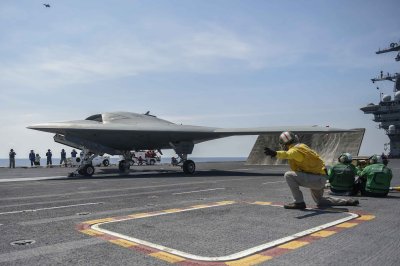
ATLANTIC OCEAN (Aug. 17, 2014) The Navy's unmanned X-47B launches from the aircraft carrier USS Theodore Roosevelt (CVN 71). The aircraft completed a series of tests demonstrating its ability to operate safely and seamlessly with manned aircraft. Three days later, 175 unmanned systems experts from the military, government, academia, and private industry participated in Naval Surface Warfare Center Dahlgren Division's first Unmanned Systems Integration Workshop and Technical Exchange Meeting. The integration of autonomous unmanned aircraft systems, such as the unmanned X-47B, in the aircraft carrier control area was discussed at the event. "Integrating unmanned systems into the Fleet has always been the biggest challenge", said Ajoy 'AJ' Muralidhar, NSWCDD Human Systems Integration engineer and the event's lead organizer. "Technology hurdles can be overcome, but true unmanned systems integration requires us to alter our entire approach to war fighting to obtain the maximum benefit from the new capabilities". (U.S. Navy photo/Released)
DAHLGREN, Va.—June Drake stood before the nation's top military, government civilian, academia, and private industry unmanned systems experts who convened here last week and answered an unspoken question.
"Some of you may be thinking - why do we need another Unmanned Systems meeting?" said Drake, Naval Surface Warfare Center Dahlgren Division (NSWCDD) Chief Technology Officer as she kicked off the command's first Unmanned Systems Integration Workshop and Technical Exchange Meeting at the University of Mary Washington Dahlgren campus Aug. 20.
Drake answered the question in practical terms.
"Our goal is simple," said Drake, pointing out restrictions at similar industry and government forums. "This is a low cost, high-value interactive forum for practitioners to share information on work-in-progress, to share ideas, lessons learned, tips, techniques and experiences in an informal setting."
NSWCDD Commander Capt. Brian Durant also shared his perspective upon welcoming the 175 participants.
"There is no doubt that unmanned systems integration presents many challenges in the coming years as more and more systems are fielded," said Durant, naming a litany of joint services, DoD laboratories, corporations and universities representatives from across the country in attendance, pointing out that, "the topic is timely."
Throughout the event, the military and civilian practitioners made it clear to Durant and Drake that an annual NSWCDD unmanned systems technical exchange is vital to the technology's development in DoD.
"The Unmanned Systems Integration Workshop was a great opportunity for leaders from academia, industry, and DoD to come together and discuss the technical, ethical, and policy issues surrounding the future of unmanned systems," said Cmdr. Shawn Cowan, Senior Military Deputy for Human Systems Engineering at NSWCDD. "Sharing information on the research, acquisition, and operational lessons learned from these programs ensures NAVSEA (Naval Sea Systems Command) is providing innovative and cost effective solutions for the warfighter. I'm looking forward to future workshops and involving more fleet representatives to provide their feedback and shape the direction of future systems."
The answers to Drake's question continued after the technical exchange.
"This workshop has been both timely and vital," said Dr. Daniel Wallace, the Navy's Technical Warrant Holder for Displays and Human Factors Engineering. "Timely, in that there is a virtual explosion recently in the exploitation of unmanned systems in both the commercial and DoD sectors. With such rapid expansion, there is both chaos and opportunity. The challenges we face involve legal issues, moral debate, and consideration of the proper roles of humans (as supervisors of the technology), as well as the more common system development and programmatic issues of cost, schedule, efficacy, and efficiency, make this a vital issue to address now."
Moreover, unmanned systems are increasingly being called upon to carry weapons.
"We need a unified strategy to tackle these issues across the joint DoD and federal level, and with our coalition partners as well," said Wallace. "This workshop and the cooperation with TTCP (The Technical Cooperation Program) will reduce the risks associated with integrating these unmanned technologies."
Dr. Yvonne Masakowski, Naval Undersea Warfare Center (NUWC) Human Factors Psychologist, outlined TTCP's interest in unmanned systems as a focus area. According to its website, "The Technical Cooperation Program is an international organization that collaborates in defense scientific and technical information exchange, program harmonization and alignment, and shared research activities for the five nations (Australia, Canada, New Zealand, United Kingdom, and the United States)."
At one point, Wallace joined panelists from the Office of Naval Research, NSWC Indian Head Division, NSWCDD, and the Southwest Research Institute in a discussion about the challenges the technical community faces in the integration of unmanned systems throughout the science, technology and acquisition cycle into warfighter accepted unmanned systems.
"Integrating unmanned systems into the Fleet has always been the biggest challenge", said Ajoy 'AJ' Muralidhar, NSWCDD Human Systems Integration engineer and the event's lead organizer. "Technology hurdles can be overcome, but true unmanned systems integration requires us to alter our entire approach to warfighting to obtain the maximum benefit from the new capabilities".
In all, 21 unmanned systems experts presented 16 briefs, including: Trust: An Important Concept for Army Unmanned Systems Applications; Decision Making for Human-Machine Collaboration in Complex Environments; and Integration of an Autonomous Unmanned Aircraft Systems (UAS) in the Carrier Control Area: UAS Operator Level of Intervention and Operational Observations.
"The energy that has been built around this topic was evident not just by the technical, but also the philosophical temperament of the questions being raised throughout the day," said Greg Buchanan, NSWCDD Platform System Safety Branch engineer. "If unmanned systems are to become integral to the way we do warfare, then it will take investment from many corners of DoD and applicable civilian communities at all levels. It will also take an understanding of how the new mission capabilities of these systems will impact our current systems and the warfighter in a systems of systems environment."
NSWCDD engineer John Canning, who presented the event's first brief, told his colleagues why it's advantageous, from a moral standpoint, to pursue the development of autonomous weapon systems.
Most DoD scientists and engineers don't have to wrestle with the ethics and legal issues associated with the weapon systems that they develop.
"A gun is a gun, and that is about all we had to know from that perspective," said Canning. "The advent of the concept of autonomous weapon systems throws the door open wide for these sorts of in-depth considerations, and the accompanying policies for their design and use."
Canning, Buchanan, Wallace and Cowen engaged in profound and thorough discussions and considerations with their colleagues from DoD organizations such as ONR, Naval Air Systems Command, NAVSEA, Naval Research Lab, U.S. Coast Guard, Army Research Lab, Naval Air Warfare Center Training Systems Division Orlando, three Joint Chief of Staff Directorates, Joint Interoperability Test Command, NUWC, NSWC Carderock, NSWC Indian Head Explosive Ordnance Disposal Technology Division and subject matter experts from a myriad of private companies in addition to academic institutions that include Virginia Polytechnic Institute and State University, Pennsylvania State University Applied Research Laboratory, Morgan State University, Old Dominion University, George Mason University, University of Maryland and Johns Hopkins University Applied Physics Laboratory.
"The exchange of ideas between the broad array of participants allows us to see other possible approaches to our own problems that we might not have thought of in isolation by ourselves," said Canning. "Events such as this allow us to envision a path forward with new ideas, and to begin to focus our personal efforts in that direction."


